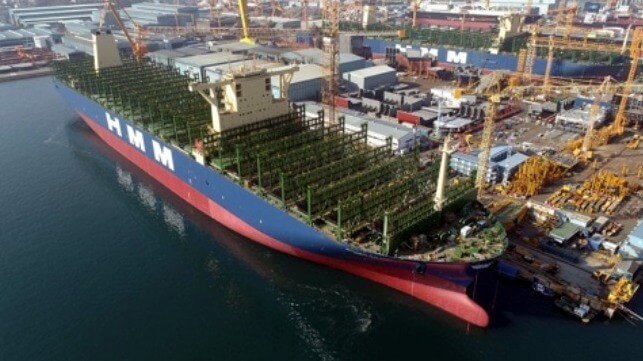Containerships for First Time Are Largest Segment of Orderbook

Global shipbuilding orders have been enjoying a strong rebound versus the lows experienced just a few years ago. In part driven by strong shipping demand since the onset of the pandemic, orders have risen strongly in part led by the containership sector and growing demand for LNG carriers reflecting the changing global energy patterns. Orders have continued strong into 2022, especially for alternative fuel vessels, but one segment, containerships, continues to set new records.
“The containership orderbook is now larger than both the tanker and bulker orderbooks in dwt for the first time,” writes Clarksons Research. The British research firm makes the observation in its latest comments about the shipbuilding outlook as of mid-year 2022. They highlight that while tankers and bulkers together account for three-quarters of world fleet dwt capacity, ordering in those segments continues at historically low levels while container shipping orders have continued at a record pace.
Clarksons reports that the global orderbook for containerships has now reached 72.5 million dwt. This compares with 63 million dwt on order for new bulkers and an even lower 34 million dwt for a combination of crude oil and product tankers, a new low for the segment.
Orders for new containerships began to build in the second half of 2020 and now they are nearing 900 vessels with a capacity of over 7 million TEU. Alphaliner in its latest update of the Top 100 ranking, reports there is a total capacity in container shipping of nearly 26 million TEU, meaning if there are no scrapings capacity would increase by more than a quarter when all the current orders are delivered. There are currently more than 6,400 active containerships representing a total of over 309 million dwt.
Tankers hurt by the long downturn in the sector and long-term forecasts for oil demand remain at the bottom of their cycle. Currently, Clarksons says there is just 35 million dwt in the crude and product tanker categories on order. “The tanker orderbook is now the smallest it has been in 25 years,” writes Clarksons. Bulker orders they report stand currently at just over 64 million dwt.
Containership orders started with a concentration on vessels around 15,000 to 18,000 TEU with many operators seeking this as the most versatile section of the industry. The major carriers however also began a new race to the largest with MSC, Hapag-Lloyd, and ONE all planning the introduction of their first 24,000 TEU. However, there continues to also be strong demand at the other end of the spectrum with strong orders for feeder ships with capacities between 6,000 and 8,000 TEU.
The strength of the orderbooks has also extended out the delivery times. Containership orders reach to 2025 and last week the South Korean shipbuilders industry highlighted that many of their building slots for 2025 are now booked. Orders are being scheduled into 2026.
A third of all the vessel orders being placed in 2022 Clarksons wrote in another report are for alternative-fueled vessels. While LNG remains the most popular currently available option, an increasing number of orders are being placed for methanol, ammonia, and hydrogen-ready capabilities. They reported that alternative-fuel vessels reached a new record with 268 vessels ordered in the first half of 2022 and accounted for nearly two-thirds of the tonnage ordered. The focus on alternative fueled vessels is also good news for the shipbuilders with these ships making up two-thirds of the contract value for shipbuilding orders.
